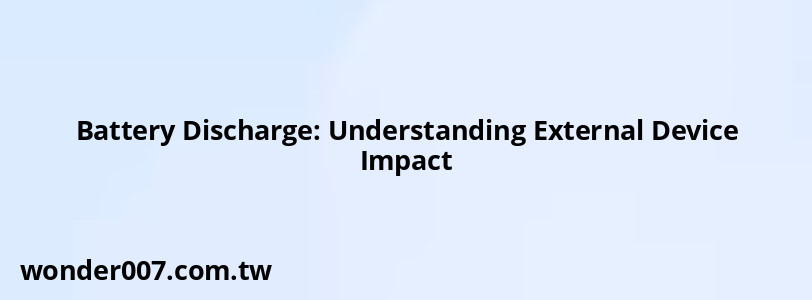Battery Discharge: Understanding External Device Impact

Battery discharge due to external electronic devices is a common concern for vehicle owners and users of portable electronics. This phenomenon often leads to unexpected battery failures, particularly when devices are left connected or improperly managed. Understanding the causes and solutions can help mitigate these issues.
What Causes Battery Discharge from External Devices?
Battery discharge occurs when a device draws power from the battery, leading to a depletion of stored energy. Several factors contribute to this issue:
- Parasitic Drain: This refers to the continuous power draw from devices even when the vehicle is off. Common culprits include faulty sensors, interior lights, or aftermarket accessories like dashcams that remain active in parking mode.
- Connected Accessories: Devices such as GPS units, chargers, and entertainment systems can draw power if not properly disconnected. For instance, a dashcam in parking mode can generate a significant load on the battery.
- Battery Age and Condition: Older batteries naturally lose their ability to hold charge effectively. If a battery is nearing the end of its life cycle, it may not withstand additional loads from external devices.
- Environmental Factors: Extreme temperatures can affect battery performance. Cold weather can reduce capacity, while high temperatures can accelerate discharge rates.
How to Prevent Battery Discharge Issues
To avoid battery discharge caused by external devices, consider implementing the following strategies:
- Disconnect Unused Devices: Always unplug devices when not in use. This includes chargers and any accessories that may draw power.
- Monitor Battery Health: Regularly check the condition of your battery using a multimeter. A healthy battery should read around 12.6 volts when off and approximately 14 volts when the engine is running.
- Use Battery Maintainers: For vehicles that sit idle for extended periods, consider using a solar charger or battery maintainer to keep the charge level stable.
- Inspect for Parasitic Draw: If you suspect parasitic drain, have a professional perform a diagnostic test to identify any faulty components that may be drawing power unnecessarily.
- Limit Accessory Use: Be mindful of how many electrical accessories are used simultaneously, especially when the engine is off.
Common Symptoms of Battery Discharge Due to External Devices
Recognizing the signs of battery discharge can help address issues before they lead to failure:
- Warning Messages: Many modern vehicles will display warnings indicating that the battery is discharging due to external devices.
- Frequent Jump Starts: If you find yourself needing frequent jump starts, it could indicate an underlying issue with your battery or connected devices.
- Diminished Performance: A noticeable decrease in vehicle features such as auto start/stop functionality may signal that the battery is struggling to maintain charge levels.
FAQs About Battery Discharge
- What should I do if my car battery keeps discharging?
Check for any connected devices that may be drawing power and ensure they are turned off or disconnected. - Can extreme temperatures affect my car battery?
Yes, both high and low temperatures can impact battery performance and discharge rates. - How often should I check my car battery?
It's advisable to check your car battery's health at least once every few months or before long trips.
By understanding the factors contributing to battery discharge and implementing preventive measures, users can effectively manage their batteries' health and longevity.
Related Posts
-
What Does ST Mean on a Car? Understanding the ST Badge
26-01-2025 • 200 views -
Hino Dash Lights: Understanding Warning Signals for Drivers
26-01-2025 • 300 views -
Knocking Noise: Understanding Clutch Issues in Vehicles
29-01-2025 • 205 views -
Battery for 2005 Chevy Cobalt: Top Choices & Tips
30-01-2025 • 193 views -
Battery for a 2016 Chevy Malibu: Essential Guide to Replacement
29-01-2025 • 148 views
Latest Posts
-
Rear Brake Caliper Piston Won't Compress
01-02-2025 • 317 views -
Are O2 Sensors Covered Under Warranty
01-02-2025 • 341 views -
2015 Chevy Traverse AC Recharge Port Location
01-02-2025 • 368 views -
Power Steering Fluid Leak On Passenger Side
01-02-2025 • 421 views -
How To Turn Off Paddle Shifters Mercedes
01-02-2025 • 336 views
Popular Posts
-
Power Steering and ABS Light On: Causes and Solutions
27-01-2025 • 617 views -
Hino Warning Lights: Understanding Dashboard Alerts
26-01-2025 • 643 views -
V12 Engine Costs: What You Need to Know
26-01-2025 • 638 views -
EPC Light: Understanding Causes and Solutions
26-01-2025 • 1020 views -
EPC Warning Light: What It Means for Your Vehicle
27-01-2025 • 595 views
